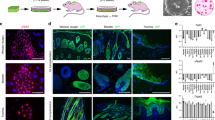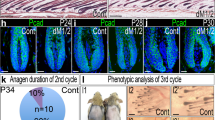Abstract
Although inductive interactions are known to be essential for specification of cell fate in many vertebrate tissues, the signals and receptors responsible for transmitting this information remain largely unidentified. Mice with mutations in the downless (dl) gene have defects in hair follicle induction, lack sweat glands and have malformed teeth1. These structures originate as ectodermal placodes, which invaginate into the underlying mesenchyme and differentiate to form specific organs2,3,4. Positional cloning of the dl gene began with identification of the transgenic family OVE1. One branch of the family, dlOVE1B, carries an approximately 600-kb deletion at the dl locus caused by transgene integration. The mutated locus has been physically mapped in this family5, and a 200-kb mouse YAC clone, YAC D9, has been identified and shown to rescue the dl phenotype in the spontaneous dlJackson (dlJ, recessive) and Dlsleek (Dlslk, dominant negative) mutants6. Here we report the positional cloning of the dl gene, which encodes a novel member of the tumour necrosis factor (Tnf) receptor (Tnfr) family. The mutant phenotype and dl expression pattern suggests that this gene encodes a receptor that specifies hair follicle fate. Its ligand is likely to be the product of the tabby (Ta) gene, as Ta mutants have a phenotype identical to that of dl (ref. 1) mutants and Ta encodes a Tnf-like protein.
This is a preview of subscription content, access via your institution
Access options
Subscribe to this journal
Receive 12 print issues and online access
$209.00 per year
only $17.42 per issue
Buy this article
- Purchase on Springer Link
- Instant access to full article PDF
Prices may be subject to local taxes which are calculated during checkout





Similar content being viewed by others
References
Lyon, M.F., Rastan, S. & Brown, S.D.M. Genetic Variants and Strains of the Laboratory Mouse (Oxford University Press, Oxford, 1996).
Gruneberg, H. The glandular aspects of the tabby syndrome in the mouse. J. Embryol. Exp. Morphol. 25, 1–19 (1971).
Sengel, P. Morphogenesis of Skin (Cambridge University Press, Cambridge, 1976).
Hardy, M.H. The secret life of the hair follicle. Trends Genet. 8, 55–61 (1992).
Shawlot, W., Siciliano, M.J., Stallings, R.L. & Overbeek, P.A. Insertional inactivation of the downless gene in a family of transgenic mice. Mol. Biol. Med. 6, 299– 307 (1989).
Majumder, K. et al. YAC rescue of downless locus mutations in mice. Mamm. Genome 9, 863–868 (1998).
Kozak, M. The scanning model for translation: an update. J. Cell Biol. 108, 229–241 (1989).
Gruss, H.J. & Dower, S.K. Tumor necrosis factor ligand superfamily: involvement in the pathology of malignant lymphomas. Blood 85, 3378–3404 (1995).
Nainsmith, J.H. & Sprang, S.R. Modularity in the TNF-receptor family. Trends Biol. Sci. 23, 74–79 (1998).
Feinstein, E., Kimchi, A., Wallach, D., Boldin, M. & Varfolomeev, E. The death domain: a module shared by proteins with diverse cellular functions. Trends Biochem. Sci. 20, 342–344 (1995).
Kaghad, M., Maillet, L. & Brulet, P. Retroviral characteristics of the long terminal repeat of murine E. Tn sequences. EMBO J.. 4, 2911 –2915 (1985).
Tartaglia, L.A., Ayres, T.M., Wong, G.H.W. & Goeddel, D.V. A novel domain within the 55 kd TNF receptor signals cell death. Cell 74, 845–853 (1993).
Bitgood, M.J. & McMahon, A.P. Hedgehog and BMPs are co-expressed at many diverse sites of cell-cell interaction in the mouse embryo. Dev. Biol. 172, 126–138 (1995).
St-Jacques, B. et al. Sonic hedgehog signaling is essential for hair development. Curr. Biol. 8, 1058–1068 (1998).
Kere, J. et al. X-linked anhidrotic (hypohidrotic) ectodermal dysplasia is caused by mutation in a novel transmembrane protein. Nature Genet. 13, 409–416 (1996).
Ferguson, B.M. et al. Cloning of Tabby, the murine homologue of the human EDA gene: evidence for a membrane associated protein with a short collagenous domain. Hum. Mol. Genet. 6, 1589– 1594 (1997).
Srivastava, A.K. et al. The Tabby phenotype is caused by mutation in a mouse homologue of the EDA gene that reveals novel mouse and human exons and encodes a protein (ectodysplasin-A) with collagenous domains. Proc. Natl Acad. Sci. USA 94, 13069–13074 (1997).
Gruss, H.J. Molecular, structural, and biological characteristics of the tumor necrosis factor ligand superfamily. Int. J. Clin. Lab. Res. 26, 143–159 (1996).
Montonen, O. et al. The gene defective in anhidrotic ectodermal dysplasia is expressed in developing epithelium, neuroectoderm, thymus, and bone. J. Histochem. Cytochem. 46, 281–289 (1998).
Soafer, J.A. Differences between tabby and downless mouse epidermis and dermis in culture. Genet. Res. 23, 219– 225 (1974).
Pennycuik, P.R. & Raphael, K.A. The tabby locus (Ta) in the mouse: its site of action in tail and body skin. Genet. Res. 43, 51–63 (1984).
Mann, S.J. Prenatal formation of hair follicle types. Anat. Rec. 144, 135–142 (1962).
Hardy, M.H. The differentiation of hair follicles and hairs in organ culture. Adv. Biol. Skin 9, 35–60 (1969).
Falconer, D.S. Total sex linkage in the house mouse. Z. induktive Abstammungs Vererbungslehre 85, 210–219 (1953).
Vielkind, U. & Hardy, M.H. Changing patterns of cell adhesion molecules during mouse pelage hair follicle development. Acta Anat. 157, 183–194 (1996).
van Genderen, C. et al. Development of several organs that require inductive epithelial-mesenchymal interactions is impaired in LEF-1-deficient mice. Genes Dev. 8, 2691–2703 (1994).
Monreal, A.W. et al. Mutations in the human homologue of the mouse dl gene cause autosomal recessive and dominant hypohidrotic ectodermal dysplasia. Nature Genet. 22, 366– 369 (1999).
Segre, J.A., Nemhauser, J.L., Taylor, B.A., Nadeau, J.H. & Lander, E.S. Positional cloning of the nude locus: genetic, physical, and transcriptional maps of the region and mutations in the mouse and rat. Genomics 28, 549– 559 (1995).
Angerer, L.M. & Angerer, R.C. In situ hybridization to cellular RNA with radiolabelled RNA probes. in In Situ Hybridization: A Practical Approach (ed. Wilkinson, D.G.) 15–32 (IRL Press, Oxford, 1992).
Byrne, C., Tainsky, M. & Fuchs, E. Programming gene expression in developing epidermis. Development 120, 2369– 2383 (1994).
Acknowledgements
We thank K. Majumder for sharing unpublished data and reagents; D. Roop and A. Schumacher for critically reading this manuscript; A. McMahon for providing Shh cDNA; and the Genetics Institute, Inc., for providing Bmp4 cDNA. This research was supported by NIH grants AR45316 and HL49953.
Author information
Authors and Affiliations
Corresponding author
Rights and permissions
About this article
Cite this article
Headon, D., Overbeek, P. Involvement of a novel Tnf receptor homologue in hair follicle induction . Nat Genet 22, 370–374 (1999). https://doi.org/10.1038/11943
Received:
Accepted:
Issue Date:
DOI: https://doi.org/10.1038/11943
This article is cited by
-
EDA ligand triggers plasma membrane trafficking of its receptor EDAR via PKA activation and SNAP23-containing complexes
Cell & Bioscience (2023)
-
Gene network analysis reveals candidate genes related with the hair follicle development in sheep
BMC Genomics (2022)
-
Elevated EDAR signalling promotes mammary gland tumourigenesis with squamous metaplasia
Oncogene (2022)
-
Identification and characterization of circRNAs in the skin during wool follicle development in Aohan fine wool sheep
BMC Genomics (2020)
-
Divergently expressed RNA identification and interaction prediction of long non-coding RNA and mRNA involved in Hu sheep hair follicle
Scientific Reports (2019)



